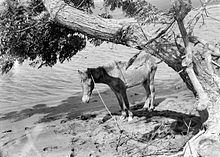Scientific name Equus caballus Rank Breed | Higher classification Horse | |
 | ||
Similar Batak pony, Basuto pony, Java Pony, Timor Pony, Sumbawa Pony | ||
The Bali pony is an ancient breed now living on the Indonesian island of Bali.
Contents
Characteristics
The Bali ponies are quite hardy and self-sufficient, surviving with little outside care. They are tough animals that are not shod and are remarkably sound, with hard feet, and strong legs. The ponies show the usual "primitive markings" such as a dorsal stripe, shoulder bars, and zebra stripes on the legs, in addition to their dun coat, that includes a black mane, tail, and legs.
The ponies lack the traditionally "pretty" conformation, having a large and unrefined head, and upright shoulder that produces short and choppy strides. The chest and back are narrow, although the neck is usually of a good length. The ponies usually range from 12-13 hands. Both the conformation and the coloration produce a pony that looks similar to the Przewalski's Horse.
Breed history
Its roots are unknown, although one theory is that ponies of ancient stock were brought to Indonesia by the Chinese in the 6th century. If this theory is true, the Bali pony would owe much of its roots to the Mongolian horse.
In addition to the Mongolian horse, it is known that some Indian stock were taken to Indonesia (although it is unknown exactly which breeds), and the Dutch also brought various eastern breeds to the country during the 18th century. Therefore, the Bali pony likely has been influenced by both the Mongolian horse, and various other eastern breeds.
Uses
The Bali pony has not been selectively bred for any particular set of characteristics. However, they easily perform the tasks required by the native people, including carting coral and stones from the beach. Their strength has also made them a popular mount for trekking and sightseeing tourists.
